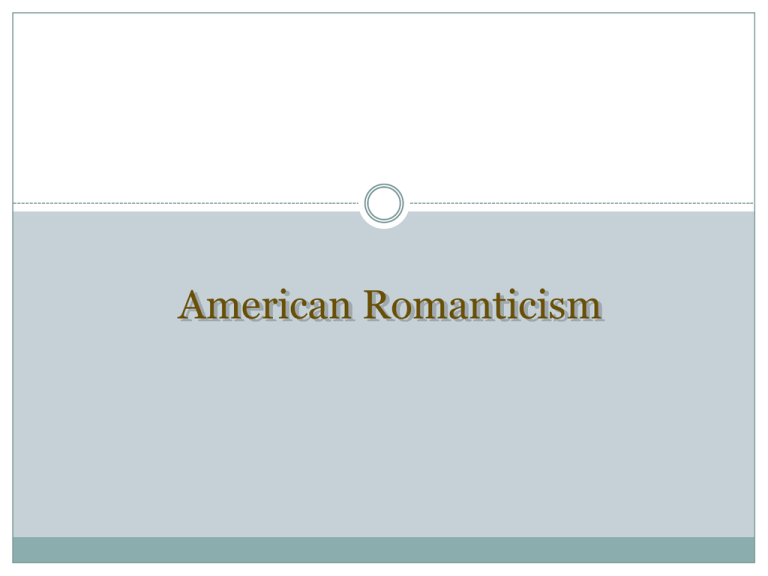Annotated Timeline of The American Literary Movement
advertisement

American Romanticism Overview Of Literary Time Periods 1. 2. 3. 4. 5. 6. 7. 8. 9. Puritan/Colonial (1650-1750) Revolutionary/Age of Reason (1750-1800) Romanticism (1800-1860) American Renaissance/ Transcendentalism (1840-1860) Realism (1855-1900) The Moderns (1900-1950) Harlem Renaissance (1920s) Post-Modernism (1950 to present) Contemporary (1970s-Present) Review: Puritan/Colonial Period (1650-1750) Genre/Style :Sermons, religious tracts, diaries, personal narratives, religious poems. It was written in plain style. Effect/Aspects :Instructive, reinforces authority of the Bible and the church. Very little imaginative literature was produced. Historical Context :Puritan settlers fled England where they were being persecuted for their religious beliefs, and came to New England to have religious freedom. Review: Revolutionary Period/Age of Reason (1750-1800) Overview of Revolutionary Period/Age of Reason Genre/Style :Political Pamphlets, Travel Writing, and highly ornate persuasive writing. Effect/Aspects :Patriotism and pride grows, creates unity about issues, and creates American character. Historical Context :Encouraged Revolutionary War support. Westward Expansion 1801-1861 AMERICA ESTABLISHES ITS BOUNDARIES Big Ideas… Between 1801 and 1861, exploration was encouraged as America underwent vast territorial expansion and settlement. Westward migration was influenced by geography and economic opportunity. Prior to the Civil War, most industrialization in America was in the North; however, the equipment produced in the North had an impact on the farming society in the South. Post-Revolutionary America The Louisiana Purchase New territories added to the United States after 1801 Louisiana Purchase Jefferson bought land from France (the Louisiana Purchase), which doubled the size of the United States. In the Lewis and Clark expedition, Meriwether Lewis and William Clark explored the Louisiana Purchase from the Mississippi River to the Pacific Ocean. Lousiana Purchase Other Territories Florida Spain gave Florida to the United States through a treaty. Texas Texas was added after it became an independent republic. Oregon The Oregon Territory was divided by the United States and Great Britain. California War with Mexico resulted in California and the southwest territory becoming part of the United States. Florida, Texas, Oregon, California Factors affecting westward expansion Geographic and economic factors that influenced westward movement Population growth in the eastern states Availability of cheap, fertile land Economic opportunity, e.g., gold (California Gold Rush), logging, farming, freedom (for runaway slaves) Cheaper and faster transportation, e.g., rivers and canals (Erie Canal), steamboats Knowledge of overland trails (Oregon and Santa Fe) Belief in the right of “Manifest Destiny”—The idea that expansion was for the good of the country and was the right of the country Romanticism (1800-1860) Overview of Romanticism Genre/Style :Character Sketches, Slave Narratives, Poetry, and short stories. Effect/Aspects :Integrity of nature and freedom of imagination. Emphasis on emotion and individualism Historical Context :Publishing expands and industrial revolution brings new ideas. Characteristics of American Romanticism Values feeling and Prefers youthful intuition over reason Places faith in inner experience and the power of the imagination Shuns the artificiality of civilization and seeks unspoiled nature innocence to educated sophistication Champions individual freedom and the worth of the individual Contemplates nature’s beauty as a path to spiritual and moral development Characteristics (continued) Looks backward to the Sees poetry as the wisdom of the past and distrusts progress Finds beauty and truth in exotic locals, the supernatural realm, and the inner world of the imagination highest expression of the imagination Finds inspiration in myth, legend, and fold culture The Industrial Revolution 1870-1960 MASS PRODUCTION OF POWER AND GOODS The First and Second Industrial Revolutions The first, or old, Industrial Revolution took place between about 1750 and 1870 Took place in England, the United States, Belgium, and France Saw fundamental changes in agriculture, the development of factories, and rural-to-urban migration The second Industrial Revolution took place between about 1870 and 1960 Saw the spread of the Industrial Revolution to places such as Germany, Japan, and Russia Electricity became the primary source of power for factories, farms, and homes Mass production, particularly of consumer goods Use of electrical power saw electronics enter the marketplace (electric lights, radios, fans, television sets) The Spread of the Industrial Revolution Mid-1800s – Great Britain, the world leader in the Industrial Revolution, attempted to ban the export of its methods and technologies, but this soon failed 1812 – United States industrialized after the War of 1812 After 1825 – France joined the Industrial Revolution following the French Revolution and Napoleonic wars Circa 1870 – Germany industrialized at a rapid pace, while Belgium, Holland, Italy, Sweden, and Switzerland were slower to industrialize By 1890 – Russia and Japan began to industrialize





